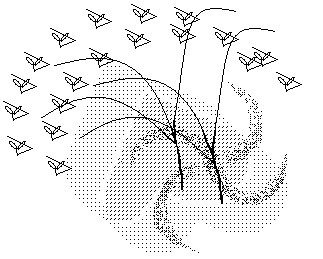Haiku and the Pictograph in EL, "willows start"
by Akihiro Kitano - March 2007 -

 .
.  .
.  .
. 
 .
. 

This is an EL (Earth Language) experimental page to enjoy
the image of a haiku/short
poem originally in English/Japanese.
When you can't see the Japanese parts, please
don't mind and just skip those parts
, or see
here to view
Japanese.
地球語の文字や文字絵を用いて詩的表現や翻訳を試みる実験のページです。
Mr. Akihiro Kitano in Hyogo, Japan recently
gifted me with his beautiful new book:
"haiku collection The Forth Movement." He'll soon be 88 years old and
is almost blind;
but has read this corner every month with magnifying glass to cheer
me with comments.
Being an engineer, he has walked his life with writing haiku since
1942. Probably haiku has
given him energy to overcome his difficult times from glaucoma, losing
his wife and bone fracture.
His grandson and daughter published this book, collecting a thousand
haiku by the author,
Kitano's own selection. Kitano has also enjoyed singing in a choral
group; and made this
book title as the forth movement of his life symphony.
His haiku images are like photos of moments showing constancy of beauty
in his daily life.
For here, I picked the most seasonable one for March in his region
of Japan.
In the pictograph, trees are going to sprout in their life-pulse.
兵庫県の北野晶裕さんが『句集 第四楽章』をお贈りくださいました。
北野さんは、技術者でありながら1942年以来俳句とともに歩んでこられ、まもなく88歳、
お目がご不自由な中、いつもこのコーナーを虫眼鏡でご覧になっては励ましてくださっています。
緑内障、奥様のご逝去、骨折などの苦境で何度か中断しながらもお続けになった俳句が、
北野さんの大きな支えになってきたのだと想います。1978年以降の一千句を自選して、
お孫さん、お嬢さんの手でこのたび出版にいたったということです。
コーラスで「第九」などもお歌いになるところから、タイトルを、(彼の人生の)『第四楽章」とされました。
一面の花野目つむれば虫野
日が落ちて簾の表裏入れ替わる
窓は秋雨粒ためらいては走る
窓の冬陽畳に平行四辺形
身近な日常世界のなかから美の一瞬を捉えた写真のような俳句ですね。
今回は、平成13~15年の中から、関西の3月らしい句を使わせていただきます。
文字絵では、作者のいのちと共振する躍動のなかで木が伸びようとしています。
 The original Japanese by Akihiro Kitano:
The original Japanese by Akihiro Kitano:
芽吹くため柳は枝を揺りはじむ
The English translation:
willows start
shaking its branches
to sprout
The EL translation:









The symbols in the pictograph
 : branch(枝),
: branch(枝),  : sprout(芽),
: sprout(芽),  : heading to (向かう方向)
: heading to (向かう方向)
 : tree (木),
: tree (木),
 : life (いのち),
: life (いのち),  : shaking(ゆれ)
: shaking(ゆれ)
The symbols in the EL translation
 {dl classification bracket,
{dl classification bracket,
 tree}: to
show the following symbol is a kind of tree related to its meaning (次の文字の意味を特徴とする木の名前を示すマーク)
tree}: to
show the following symbol is a kind of tree related to its meaning (次の文字の意味を特徴とする木の名前を示すマーク)
 {
{ water,
water, edge,
edge,
 place}: waterside (水辺)
place}: waterside (水辺)

 : willow
: willow
(But this is just a tentative idea now: scientific names would be studied
later by specialists)(柳:まだ仮の設定です。)
 : to form an e-verb: meaning that the subject lets the
: to form an e-verb: meaning that the subject lets the  -headed person/thing into the condition shown by the following characters.
(これに続く状態に
-headed person/thing into the condition shown by the following characters.
(これに続く状態に 以下のものをならせる意味の動詞を構成する動詞符)
以下のものをならせる意味の動詞を構成する動詞符)
 {
{ moving,
moving, waving}: shaking, shake (vi. with #gd/ vt. with #ge)(ゆれ、震え)
waving}: shaking, shake (vi. with #gd/ vt. with #ge)(ゆれ、震え)
 {
{ thing,
thing,  open}:
starting, beginning (はじめ)
open}:
starting, beginning (はじめ)


 : (vt.) start shaking (the thing after
: (vt.) start shaking (the thing after  -mark)(揺らしはじめる)
-mark)(揺らしはじめる)
 {
{ ,
, plant}(a fundamental ideogram by the total shape): branch(es) (枝)
plant}(a fundamental ideogram by the total shape): branch(es) (枝)
 {
{ preposition mark,
preposition mark,  verb-mark,
verb-mark,
 heading direction}
heading direction}
(working as a qualifier for the predicate): being to ... (~するために、~しようとして)
 {
{ ,
, plant}(by the total shape): sprout (芽)
plant}(by the total shape): sprout (芽) 
 : sprout (vi.) (芽、動詞:芽立つ)
: sprout (vi.) (芽、動詞:芽立つ)
* I imagined the "willow/Yanagi" as the Japanese kind of tree here.
If imagining Willow called in California, the flower bud comes out earlier
than the leaf.
In that case, you can use 

 (start buds out) instead of
(start buds out) instead of 
 .
.
(アメリカでの柳は、ふつう猫柳を指します。その場合には蕾が先に出るので、
葉の芽 の代わりに蕾
の代わりに蕾 を用いるとイメージしやすいかもしれません)
を用いるとイメージしやすいかもしれません)
* 北野さんによると、六甲を源とする小川がお宅の前で小さな滝となり、その水辺にこの一本の柳があるそうです。
拝見したとき私も一本の柳を想いましたが、英語と文字絵では複数にしてみました。
今見ているのは1本でも、そのいのちの躍動が他の柳にも自分の細胞にも連なってゆくイメージで。
to
the top
 The original Japanese by Akihiro Kitano:
The original Japanese by Akihiro Kitano:







 : branch(枝),
: branch(枝),  : shaking(ゆれ)
: shaking(ゆれ) {dl classification bracket,
{dl classification bracket,
 {
{ water,
water, edge,
edge,

 : willow
: willow  {
{ {
{ thing,
thing, 
 {
{ ,
, {
{ verb-mark,
verb-mark,
 ,
,


 (start buds out) instead of
(start buds out) instead of 
 を用いるとイメージしやすいかもしれません)
を用いるとイメージしやすいかもしれません)